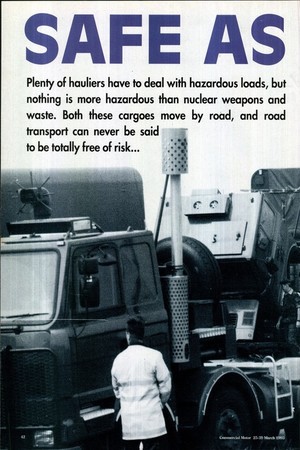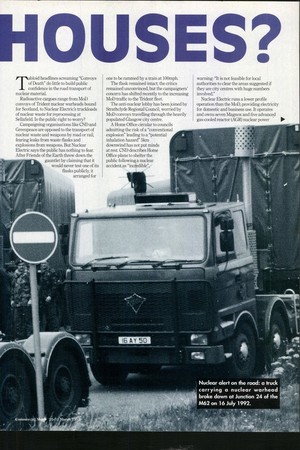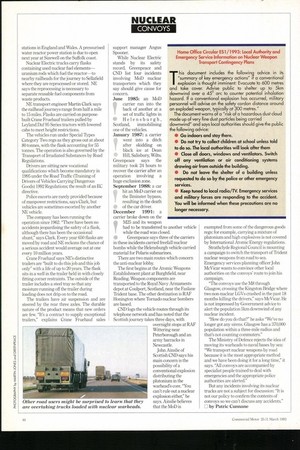SAFEAS
Page 44

Page 45

Page 46

If you've noticed an error in this article please click here to report it so we can fix it.
Plenty of hauliers have to deal with hazardous loads, but nothing is more hazardous than nuclear weapons and waste. Both these cargoes move by road, and road transport can never be said to be totally free of risk...
Tabloid headlines screaming "Convoys of Death" do little to build public confidence in the road transport of nuclear material.
Radioactive cargoes range from MoD convoys of Trident nuclear warheads bound for Scotland, to Nuclear Electric's truckloads of nuclear waste for reprocessing at Sellafield. Is the public right to worry?
Campaigning organisations like CND and Greenpeace are opposed to the transport of nuclear waste and weapons by road or rail, fearing leaks from waste flasks and explosions from weapons. But Nuclear Electric says the public has nothing to fear. After Friends of the Earth threw down the gauntlet by claiming that it would never test one of its flasks publicly, it arranged for one to be rammed by a train at 100mph.
The flask remained intact; the critics remained unconvinced, but the campaigners' concern has shifted recently to the increasing MoD traffic to the Trident fleet.
The anti-nuclear lobby has been joined by Strathclyde Regional Council, worried by MoD convoys travelling through the heavily populated Glasgow city centre.
A Home Office circular to councils admitting the risk of a "conventional explosion" leading to a "potential inhalation hazard" 5km downwind has not put minds at rest. CND describes Home Office plans to shelter the public following a nuclear accident as "incredible", warning "It is not feasible for local authorities to clear the areas suggested if they are city centres with huge numbers involved."
Nuclear Electric runs a lower profile operation than the MoD, providing electricity for domestic and business use. It operates and owns seven Magnox and five advanced gas-cooled reactor (AGR) nuclear power stations in England and Wales. A pressurised water reactor power station is due to open next year at Sizewell on the Suffolk coast.
Nuclear Electric trucks carry flasks containing used nuclear fuel elements— uranium rods which fuel the reactor—to nearby railheads for the journey to Sellafield where they are reprocessed or stored. NE says the reprocessing is necessary to separate reusable fuel components from waste products.
NE transport engineer Martin Clark says the railhead journeys range from half a mile to 15 miles. Flasks are carried on purposebuilt Crane Fruehauf trailers pulled by Leyland Daf 95 Series tractors with lowered cabs to meet height restrictions.
The vehicles run under Special Types Category Two regs as they gross out at about 80 tonnes, with the flask accounting for 55 tonnes. The operation is also governed by the Transport of Irradiated Substances by Road Regulations.
Drivers are sitting new vocational qualifications which become mandatory in 1995 under the Road Traffic (Training of Drivers of Vehicles Carrying Dangerous Goods) 1992 Regulations; the result of an EC directive.
Police escorts are rarely provided because of manpower restrictions, says Clark, but vehicles are sometimes escorted by another NE vehicle.
The company has been running the operation since 1962. "There have been no accidents jeopardising the safety of a flask, although there has been the occasional shunt," says Clark. Every year 650 flasks are moved by road and NE reckons the chance of a serious accident would average out at one every 10 million years.
Crane Fruehauf says NE's distinctive trailers are "built to do this job and this job only" with a life of up to 20 years. The flask sits in a well in the trailer held in with closely fitting corner restraints. The outside of the trailer includes a steel tray so that any moisture running off the trailer during loading does not drip on to the road.
The trailers have air suspension and are steered by the rear three axles. The durable nature of the product means that new orders are few. "It's a contract to supply exceptional trailers," explains Crane Fruehauf sales support manager Angus Spooner.
While Nuclear Electric stands by its safety record, Greenpeace and CND list four incidents involving MoD nuclear transporters which they say should give cause for concern.
June 1985: an MoD carrier ran into the back of another at a set of traffic lights in • Helensburgh, Scotland, immobilising one of the vehicles. January 1987: a carrier • went into a ditch after skidding on black ice at Dean • Hill, Salisbury, Wilts. Greenpeace says the military took 24 hours to recover the carrier after an operation involving a huge exclusion zone.
September 1988: a car hit an MoD carrier on the Ilminster bypass, resulting in the death • of the car driver. December 1991: a carrier broke down on the IM25 and its weapon had to be transferred to another vehicle while the road was closed.
• Greenpeace says three of the carriers in these incidents carried freefall nuclear bombs while the Helensburgh vehicle carried material for Polaris submarines.
There are two main routes which concern the anti-nuclear lobby.
The first begins at the Atomic Weapons Establishment plant at Burghfield, near Reading. Weapon components are transported to the Royal Navy Armaments depot at Coulport, Scotland, near the Faslane Trident base. The other destination is RAF Honington where Tornado nuclear bombers are based.
CND logs the vehicle routes through its telephone network and has noted that the Scottish journey takes three days, with overnight stops at RAF Wittering near Peterborough and an army barracks in Newcastle.
John Ainslie of Scottish CND says his main concern is the possibility of a conventional explosion distributing the plutonium in the warhead's core. "You can't rule out a nuclear explosion either," he says. Ainslie believes that the MoD is exempted from some of the dangerous goods regs: for example, carrying a mixture of plutonium and high explosives is not covered by International Atomic Energy regulations.
Strathclyde Regional Council is mounting a campaign to switch the transport of Trident nuclear weapons from road to sea. Emergency services planning officer John McVicar wants to convince other local authorities on the convoys' route to join his campaign.
"The convoys use the M8 through Glasgow, crossing the Kingston Bridge where two non-nuclear LGVs crashed in the past 18 months killing the drivers," says McVicar. He is not impressed by Government advice to alert the population 51an downwind of any nuclear incident.
"How do you do that?" he asks "We've no longer got any sirens. Glasgow has a 370,000 population within a three-mile radius and that's not counting commuters."
The Ministry of Defence rejects the idea of moving its warheads to naval bases by sea: "We transport nuclear weapons by road because it is the most appropriate method and we have been doing it for a long time," it says. "All convoys are accompanied by specialist people trained to deal with emergencies and the appropriate police authorities are alerted."
But any incidents involving its nuclear trucks are not a subject for discussion: "It is not our policy to confirm the contents of convoys so we can't discuss any accidents." El by Patric Curmane Home Office Circular ES1/1993: Local Authority and Emergency Service Information on Nuclear Weapon Transport Contingency Plans This document includes the following advice in its his of key emergency actions" if a conventional explosion is thought imminent: Evacuate to 600 metres and take cover. Advise public to shelter up to 5km downwind over a 450arc to counter potential inhalation hazard. If a conventional explosion has occurred, military personnel will advise on the safety cordon distance around an exploded weapon, typically at 300 metres."
The document warns of a "risk of a hazardous dust cloud made up of very fine dust particles being carried downwind" and says local authorities should give the public the following advice: Go indoors and stay there.
Do not try to collect children at school unless told to do so. The local authorities will look after them Close all doors, windows and ventilators. Switch off any ventilation or air conditioning systems drawing air from outside the building.
Do not leave the shelter of a building unless requested to do so by the police or other emergency services.
Keep tuned to local radio/TV. Emergency services and military forces are responding to the accident. You will be informed when these precautions are no longer necessary.




















































































